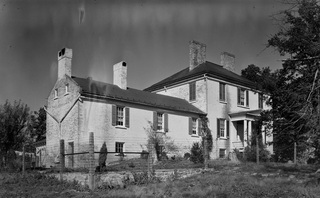 | Back to e-WV
| Back to e-WV
 The West Virginia Encyclopedia
The West Virginia Encyclopedia
 | Back to e-WV
| Back to e-WV
 The West Virginia Encyclopedia
The West Virginia Encyclopedia

While closely associated in the public mind with Mount Vernon and other sites in the Tidewater section of Virginia, in the years surrounding the Revolutionary War the Washington family began a migration that carried most of George Washington’s closest relatives to the upcountry of the present Eastern Panhandle of West Virginia.Today more Washington family descendants are buried in Jefferson County than in any other place in the country.
The Washington family became acquainted with the rich agricultural lands of present Jefferson County when George Washington at age 16 helped to survey lands for Lord Fairfax in 1748. Two years later, young Washington bought 550 acres of land on the South Fork of Bullskin Run, near Charles Town. Here he established his Rock Hall plantation.
George’s half-brother, Lawrence, acquired several thousand acres in the Bullskin and Evitts Run area. Lawrence Washington died in 1752, leaving no children. His land went to his brother, Augustine Washington (1718–62), and to his half-brothers George Washington, who inherited Mount Vernon from Lawrence, Samuel Washington (1734–81), John Augustine Washington (1736–87), and Charles Washington (1738–99).
Samuel Washington was the first to move to present Jefferson County. He moved to the native limestone house he built and named Harewood in 1770. When Samuel died at age 47 in 1781, he left a widow and five young children. Samuel’s son, George Steptoe Washington, married Lucy Payne in 1793. Lucy’s widowed sister, Dolley Payne Todd, was married at Harewood to James Madison, who became president in 1809. Harewood, near Charles Town, still remains in the Washington family.
Charles Washington laid out Charles Town in 1786 on 80 acres that he had inherited from Lawrence. Charles and his wife, Mildred, resided at Happy Retreat at Charles Town. Charles had a son, Samuel, and daughter, Mildred, who married Thomas Hammond.
Cedar Lawn, near Charles Town, was built in 1825 by John Thornton Augustine Washington (1783–1841), the grandson of George’s brother, Samuel Washington. Locust Hill (no longer standing) was built in 1840 by Samuel’s daughter, Lucy Elizabeth Washington, who married John Bainbridge Packett on part of the original Harewood land.
John Augustine Washington did not live on the land that he inherited from Lawrence, but at his death his son, Corbin Washington, inherited the land and lived there. After the death of Corbin’s wife, Hannah Lee, daughter of Richard Henry Lee, his Prospect Hill plantation in Jefferson County was divided. It consisted of 2,720 acres, 130 slaves, 15 horses, 45 horned cattle, 70 sheep, 60 hogs, and two yokes of oxen. Corbin and Hannah Washington had three sons: Richard Henry Lee Washington, who died before 1819, Bushrod Corbin (1790–1851), and John Augustine (1789–1832). When Richard Henry Lee Washington died, his land was divided among his two brothers and his sister, Mary Lee Washington Herbert, who received the Prospect Hill house, which is no longer standing. Brothers Bushrod Corbin and John Augustine Washington, the great-grandsons of George Washington’s brother, married Blackburn sisters. Bushrod built Claymont Court, and John Augustine built Blakeley on the land they had inherited between 1815 and 1820. The houses, both near Charles Town, suffered major fires and were rebuilt.
There is one other well-known Washington home in Jefferson County, Beall-Air. The early section of this house was built by Thomas Beall (1748–1819) of Georgetown. His daughter, Eliza, married George Corbin Washington, who was the grandson of Augustine, the full brother of Lawrence. It was their son, Lewis W. Washington (1812–71), who built the front section of the Beall-Air mansion about 1850. It was at Beall-Air on Sunday, October 16, 1859, that Lewis Washington was awakened by an armed group that took him to the fire-engine house at Harpers Ferry. There he became John Brown’s hostage.
George Washington’s great-grandnephew, John Augustine Washington, a lieutenant colonel in the Confederate service and an aide to Robert E. Lee, was killed in Randolph County during the Civil War. Colonel Washington was reconnoitering the Union position at Elkwater when he was shot by federal scouts on September 13, 1861. He is buried at Charles Town.
Written by Don C. Wood